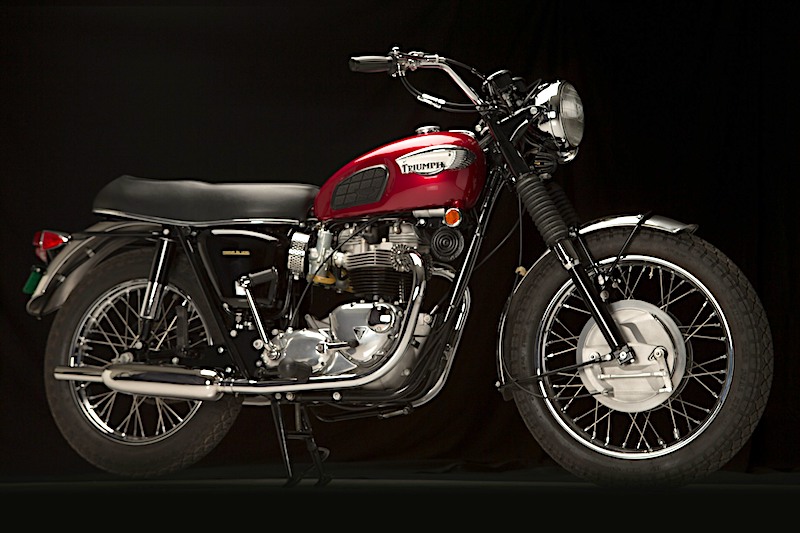Motorcycle Investor mag
Subscribe to our free email news
Triumph Bonneville
(by Ian Falloon, Feb 2022)

Falloon
picks the best of the Meriden vintages
A great wine,
such as a Grange Hermitage or
Chateau Lafitte, will always have a vintage year, that
particular year where
the weather conditions were just perfect, and the grapes
at their peak.
The same can
be said about certain
motorcycles, and the 650cc T120 Triumph Bonneville is a
particular case in
point. Rather than the variability of climactic
conditions, motorcycles can
suffer from poor managerial decisions, or the demands of
the marketplace.
This is
especially appropriate to the T120
Bonneville that, along with the single carb Trophy, was
Triumph’s production
mainstay from 1959 until 1974.
Ask any
Triumph enthusiast for an opinion on
the vintage years for the Bonneville and inevitably the
years from 1968 until
1970 will be mentioned. Before 1968 the Bonnie was
afflicted with marginal
electrics, handling and brakes, and after 1970 there was
the debacle of the
Umberslade Hall designed oil-in-the-frame version.
If one bike
typifies the sixties it is
undoubtedly the Bonnie. Because they were so ubiquitous,
to so many older
enthusiasts today it is the one bike that epitomises
youth. By 1972 it was
reckoned that 250,000 Bonnevilles had been built - at
least three times as many
as any comparable Norton or BSA twin. The Bonneville
also offered an
unparalleled balance between looks and performance at a
competitive price, and
a timeless appeal, and the ones to have were from that
pinnacle period, 1968 to
1970.
Yet it was
considerably earlier that the
Bonnie was conceived. In recognition of the speed
records at Bonneville,
Triumph boss Edward Turner decided to make the most of
this association, and in
1959 Triumph released the T120 Bonneville. This was
intended to be the
performance flagship, but initially still very much a
650cc T110 Thunderbird
hybrid.
Performance
was boosted over the 110 through
the use of a splayed-port alloy cylinder head, higher
compression, and twin
Amal monobloc carburettors without air filters. With 46
horsepower at 6,500
rpm, the Bonneville was claimed to be the fastest
production bike available, a
claim substantiated in 1961 when the British motorcycle
press tested a T120R at
188 km/h.
The first
unit construction Bonneville
appeared in 1963, and at first wasn’t as highly rated as
the pre-unit
predecessors. While there were gains in the frame, which
reverted back to the
classical Triumph single downtube, the unit construction
engine lost out in
smoothness and electrical reliability.
However,
where the new T120 really scored over
the pre-unit 650’s was in compactness and weight. At
165kg it was nearly 14kg
lighter, and this contributed to much brisker on the
road performance. Every
year saw a range of detail improvements, in particular
from 1966 onwards, but
with 1968 came one of the three top years. A new 8-inch
twin leading shoe front
brake, two-way damping in the front fork in light of
racing experience, and a
stronger race-bred swinging-arm, contributed to superior
on-the-road
performance.
This was a
particularly trying time at Meriden,
both financially and politically, and most resources
were being poured into
developing the new triples. By now the 650cc engine had
reached the zenith of
its development as a competition unit, and the
Umberslade oil-in-the-frame
models were waiting in the wings.
But the late
sixties were real boom years for
sales in the US, with over 30,000 Triumphs sold in 1969.
While Meriden was flat
out meeting demand, with production up to about 900
machines a week, quality
varied considerably, and the factory never really
mastered the high volume/high
quality equation that ultimately contributed to their
downfall.
After 1970,
just as the T120 seemed to
represent the distillation of everything that was right
about motorcycle
styling, the expensive new R&D facility at
Umberslade Hall gave birth to
the inferior oil-in-the-frame replacement. When it
appeared, enthusiasts were
mortified.
Gone were the
classic mufflers, gaitered
forks, bullet-shaped headlights, and rounded side covers
that epitomised
Triumph. What’s more the new double cradle frame was so
tall that the seat
height was a towering 876mm, and a series of initial
production problems got
them off to a very shaky start. Eventually the oil-in
the-frame twins became
solid and rideable motorcycles, but looking back now
Triumph enthusiasts lament
that the 1970 models were “the last of the good ones”.
Given some of
the reliability problems of the
late sixties, the use of the word “good” is dubious, but
what is undeniable is
that they were the last of the “classic” Triumphs, and
among the best-looking
motorcycles ever made.
-------------------------------------------------
Produced by AllMoto abn 61 400 694 722
Privacy: we do not collect cookies or any other data.

Archives
Contact





